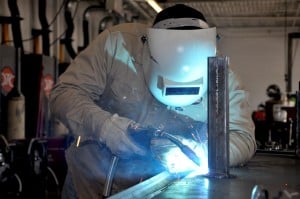MIG Welding
Are you ready for your second dose of welding?! We covered Shielded Metal Arc Welding now we will go over Gas Metal Arc Welding commonly known as MIG welding which stands for Metal Inert Gas.
Gas Metal Arc Welding utilizes a solid wire that is fed into the weld puddle by motor driven drive wheels. It is considered to be the easiest to learn and there is a wide range of small wire fed welders that are perfect for use by the home hobbyist. With wire feed welding such as MIG once you have the wire feed speed and voltage set correctly all you have to do is pull the trigger on the gun and start welding.
There are some drawbacks to MIG welding which every welder needs to understand. The biggest drawbacks of MIG welding are the need for an external shielding gas and lack of fusion. MIG uses an external gas (usually Carbon Dioxide or a Argon/Carbon Dioxide mix) to provide shielding for the weld puddle. This means that it is best suited for welding indoors or where the wind can be controlled in order to prevent the shielding gas from being blown away. Now the lack of fusion. What this means is that the MIG welding process doesn’t “dig” or penetrate very well. The welder can make a beautiful weld with it but the weld basically ends up “sitting” on top of the metal without actually penetrating and causing a bond. This problem can be overcome by using higher wire feed speeds and voltage as is used in professional welding shops but it often is a problem with home hobbyist and the smaller wire feed welders on the market today.
MIG is a very fast and efficient welding process that can be used to weld steel, stainless steel, aluminum, nickel alloys and other metals, which explains why it is one of the most commonly used welding processes in manufacturing and fabrication shops.
Learn Gas Metal Arc Welding and other common welding processes at OTC today!
More on Welding:









